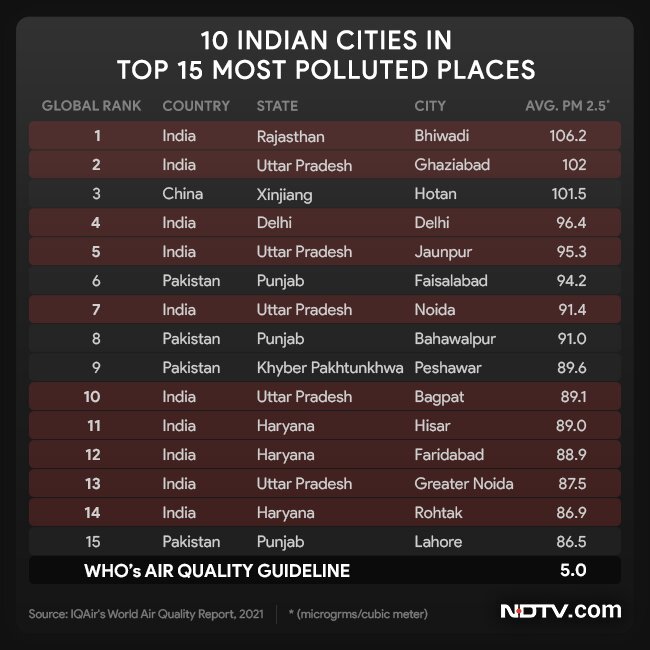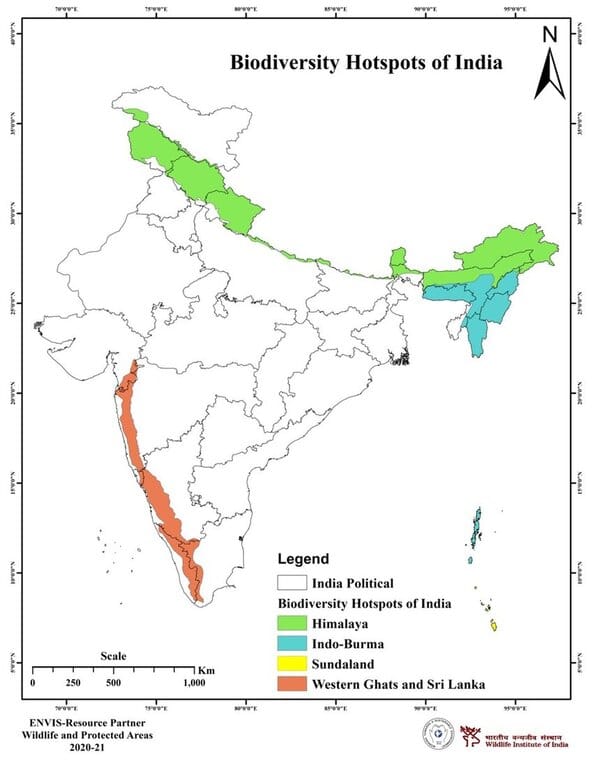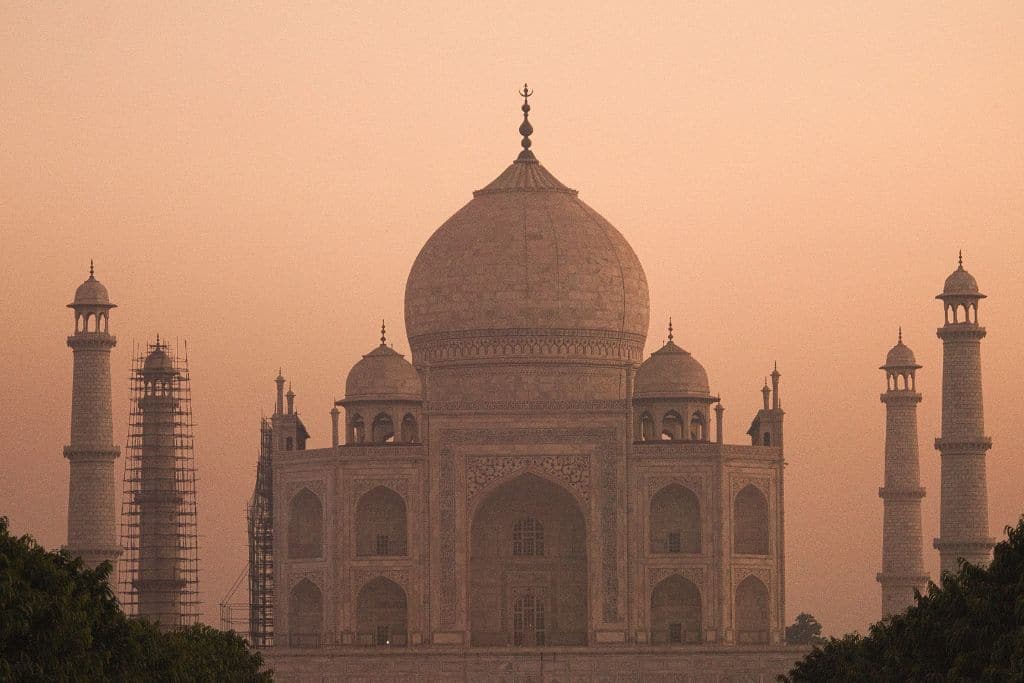In its latest climate assessment, the Intergovernmental Panel on Climate Change (IPCC) made it very clear that the climate crisis is accelerating at a pace like never before and warned that it is “now or never” to limit global warming to 1.5C. From deforestation and droughts to air pollution and plastic waste, there are several factors exacerbating global warming, with consequences felt everywhere in the world. However, some nations suffer more than others. Despite making little to no contribution to climate change, countries in the Global South historically bear the most brunt as they often lack financial resources to tackle the emergency and mitigate the impacts of extreme weather events. Here are some of the biggest environmental issues in India right now and how the country is dealing with them.
—
5 Biggest Environmental Issues in India in 2024
1. Air Pollution
Undoubtedly one of the most pressing environmental issues in India is air pollution. According to the 2021 World Air Quality Report, India is home to 63 of the 100 most polluted cities, with New Delhi named the capital with the worst air quality in the world. The study also found that PM2.5 concentrations – tiny particles in the air that are 2.5 micrometres or smaller in length – in 48% of the country’s cities are more than 10 times higher than the 2021 WHO air quality guideline level.
Vehicular emissions, industrial waste, smoke from cooking, the construction sector, crop burning, and power generation are among the biggest sources of air pollution in India. The country’s dependence on coal, oil, and gas due to rampant electrification makes it the world’s third-largest polluter, contributing over 2.65 billion metric tonnes of carbon to the atmosphere every year.
The months-long lockdown imposed by the government in March 2020 to curb the spread of Covid-19 led to a halt in human activities. This unsurprisingly, significantly improved air quality across the country. When comparing the Air Quality Index (AQI) data for 2019 and 2020, the daily average AQI in March-April 2019 was 656, the number drastically dropped by more than half to 306 in the same months of 2020.
You Might Also Like: India’s Coal Dilemma Amid Record-breaking Heatwave
Unfortunately, things did not last long. In 2021, India was among the world’s most polluted countries, second only to Bangladesh. The annual average PM2.5 levels in India was about 58.1 µg/m³ in 2021, “ending a three-year trend of improving air quality” and a clear sign that the country has returned to pre-pandemic levels. Scientists have linked persistent exposure to PM2.5 to many long-term health issues including heart and lung disease, as well as 7 million premature deaths each year. In November 2021, air pollution reached such severe levels that they were forced to shut down several large power plants around Delhi.

In recent years, the State Government of the Indian capital has taken some stringent measures to keep a check on air pollution. One of which is the Odd-Even Regulation – a traffic rationing measure under which only private vehicles with registration numbers ending with an odd digit will be allowed on roads on odd dates and those with an even digit on even dates. Starting from January 2023, there will also be a ban on the use of coal as fuel in industrial and domestic units in the National Capital Region (NRC). However, the ban will not apply to thermal power plants, incidentally the largest consumers of coal. Regardless of the measures taken to curb air pollution, as the World Air Quality Report clearly shows – the AQI in India continues to be on a dangerous trajectory.
You Might Also Like: 15 Most Polluted Cities in the World
2. Water Pollution
Among the most pressing environmental issues in India is also water pollution. The Asian country has experienced unprecedented urban expansion and economic growth in recent years. This, however, comes with huge environmental costs. Besides its air, the country’s waterways have become extremely polluted, with around 70% of surface water estimated to be unfit for consumption. Illegal dumping of raw sewage, silt, and garbage into rivers and lakes severely contaminated India’s waters. The near-total absence of pipe planning and an inadequate waste management system are only exacerbating the situation. Every day, a staggering 40 million litres of wastewater enter rivers and other water bodies. Of these, only a tiny fraction is adequately treated due to a lack of adequate infrastructure.
In middle-income countries like India, water pollution can account for the loss of up to half of GDP growth, a World Bank report suggests. Water pollution costs the Indian government between US$6.7 and $7.7 billion a year and is associated with a 9% drop in agricultural revenues as well as a 16% decrease in downstream agricultural yields.
Besides affecting humans, with nearly 40 million Indians suffering from waterborne diseases like typhoid, cholera, and hepatitis and nearly 400,000 fatalities each year, water pollution also damages crops, as infectious bacteria and diseases in the water used for irrigation prevent them from growing. Inevitably, freshwater biodiversity is also severely damaged. The country’s rivers and lakes often become open sewers for residential and industrial waste. Especially the latter – which comprises a wide range of toxic substances like pesticides and herbicides, oil products, and heavy metals – can kill aquatic organisms by altering their environment and making it extremely difficult for them to survive.
Fortunately, the country has started addressing the issue by taking steps to improve its water source quality, often with local startups’ help. One strategy involves the construction of water treatment plants that rely on techniques such as flocculation, skimming, and filtration to remove the most toxic chemicals from the water. The upgrade process at one of the country’s largest plants located in Panjrapur, Maharashtra, will enable it to produce more than 19 million cubic metres of water a day, enough to provide access to clean water to approximately 96 million people.
The government is also looking at ways to promote water conservation and industrial water reuse by opening several treatment plants across the country. In Chennai, a city in Eastern India, water reclamation rose from 36,000 to 80,000 cubic metres between 2016 and 2019.
Finally, in 2019, Gujarat – a state of more than 70 million citizens – launched its Reuse of Treated Waste Water Policy, which aims to drastically decrease consumption from the Narmada River. The project foresees the installation of 161 sewage treatment plants all across the state that will supply the industrial and construction sectors with treated water.
3. Food and Water Shortages
According to the Intergovernmental Panel on Climate Change (IPCC), India is the country expected to pay the highest price for the impacts of the climate crisis. Aside from extreme weather events such as flash floods and widespread wildfires, the country often experiences long heatwaves and droughts that dry up its water sources and compromise crops.
Since March 2022 – which was the hottest and driest month recorded in 120 years – the North West regions have been dealing with a prolonged wave of scorching and record-breaking heat. For several consecutive days, residents were hit by temperatures surpassing 40 degrees Celsius, while in some areas, surface land temperatures reached up to 60C. There is no doubt among experts that this unprecedented heatwave is a direct manifestation of climate change.
The heatwave has also contributed to an economic slowdown due to a loss of productivity, as thousands of Indians are unable to work in the extreme heat. The agriculture sector – which employs over 60% of the population – is often hit hard by these erratic droughts, impacting food stability and sustenance. Currently, farmers are struggling to rescue what remains of the country’s wheat crops, piling on existing fears of a global shortage sparked by the war in Ukraine.
Already among the world’s most water-stressed countries, the heatwave is causing further water shortages across the nations. Even though water tankers are keeping communities hydrated, the supply is not enough to cover the needs of all residents. But heat is not the only factor contributing to water scarcity. In an interview with the Times of India, lead researcher at Pune-based Watershed Organisation Trust Eshwer Kale described the national water policy as very ‘irrigation-centric’. Indeed, over 85% of India’s freshwater is used in agriculture. This has led to a crisis in several states, including Punjab, Haryana, and western Uttar Pradesh. The indiscriminate use of water for irrigation, coupled with the absence of conservation efforts and the huge policy gap in managing water resources has left over 10% of the country’s water bodies in rural areas redundant. A 2019 report predicts that 21 major cities – including New Delhi and India’s IT hub of Bengaluru – will run out of groundwater by 2030, affecting nearly 40% of the population.
You Might Also Like: Water Scarcity in India
4. Waste Management
Among the most pressing environmental issues in India is also waste. As the second-largest population in the world of nearly 1.4 billion people, it comes as no surprise that 277 million tonnes of municipal solid waste (MSW) are produced there every year. Experts estimate that by 2030, MSW is likely to reach 387.8 million tonnes and will more than double the current value by 2050. India’s rapid urbanisation makes waste management extremely challenging. Currently, about 5% of the total collected waste is recycled, 18% is composted, and the remaining is dumped at landfill sites.
The plastic crisis in India is one of the worst on the planet. According to the Central Pollution Control Board (CPCB), India currently produces more than 25,000 tonnes of plastic waste every day on average, which accounts for almost 6% of the total solid waste generated in the country. India stands second among the top 20 countries having a high proportion of riverine plastic emissions nationally as well as globally. Indus, Brahmaputra, and Ganges rivers are known as the ‘highways of plastic flows’ as they carry and drain most of the plastic debris in the country. Together with the 10 other topmost polluted rivers, they leak nearly 90% of plastics into the sea globally.
To tackle this issue, in 2020 the government announced that they would ban the manufacture, sale, distribution, and use of single-use plastics from July 1 2022 onwards. Furthermore, around 100 Indian cities are set to be developed as smart cities. Despite being still in its early phase, the project sees civic bodies completely redrawing the long-term vision in solid waste management, with smart technologies but also awareness campaigns to encourage community participation in building the foundation of new collection and disposal systems.
You Might Also Like: Smart Cities in India
5. Biodiversity Loss
Last but not least on the list of environmental issues in India is biodiversity loss. The country has four major biodiversity hotspots, regions with significant levels of animal and plant species that are threatened by human habitation: the Himalayas, the Western Ghats, the Sundaland (including the Nicobar Islands), and the Indo-Burma region. India has already lost almost 90% of the area under the four hotspots, according to a 2021 report issued by the Centre for Science and Environment (CSE), with the latter region being by far the worst affected.

Moreover, 1,212 animal species in India are currently monitored by the International Union for Conservation of Nature (IUCN) Red List, with over 12% being classified as ‘endangered’. Within these hotspots, 25 species have become extinct in recent years.
Due to water contamination, 16% of India’s freshwater fish, molluscs, dragonflies, damselflies, and aquatic plants are threatened with extinction and, according to the WWF and the Zoological Society of London (ZSL), freshwater biodiversity in the country has experienced an 84% decline.
Yet, there is more to it. Forest loss is another major driver of biodiversity decline in the country. Since the start of this century, India has lost 19% of its total tree cover. While 2.8% of forests were cut down from deforestation, much of the loss have been a consequence of wildfires, which affected more than 18,000 square kilometres of forest per year – more than twice the annual average of deforestation.
Forest restoration may be key to India’s ambitious climate goals, but some argue that the country is not doing enough to stop the destruction of this incredibly crucial resource. Indeed, despite committing to create an additional carbon sink of 2.5-3 billion tonnes of CO2 equivalent through additional forest and tree cover by 2030, Narendra Modi’s government faced backlash after refusing to sign the COP26 pledge to stop deforestation and agreeing to cut methane gas emissions. The decision was justified by citing concerns over the potential impact that the deal would have on local trade, the country’s extensive farm sector, and the role of livestock in the rural economy. However, given these activities’ dramatic consequences on biodiversity, committing to end and reverse deforestation should be a priority for India.
If you liked reading about some of the biggest environmental issues in India, you might also like: 14 Biggest Environmental Problems of 2024
This story is funded by readers like you
Our non-profit newsroom provides climate coverage free of charge and advertising. Your one-off or monthly donations play a crucial role in supporting our operations, expanding our reach, and maintaining our editorial independence.
About EO | Mission Statement | Impact & Reach | Write for us


















